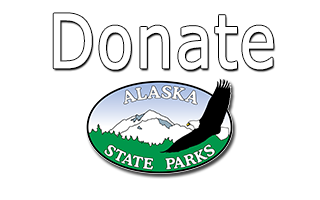Glacial Rivers
For you safety, Alaska State Parks made a short video to help hikers cross Eagle River on the Crow Creek Trail. Please take the time to view the movie if you are planning any river crossing. Crossing Eagle River on the Crow Creek Trail Video (.mp4)
Glacial Rivers
 Wild and silty rivers run from the park's glaciers to Alaska's coastlines. These rivers look different and act different than most rivers. Icy cold temperatures, fluctuating levels, changing channels, and heavy loads of silt and rock can challenge hikers, boaters, and anglers.
Wild and silty rivers run from the park's glaciers to Alaska's coastlines. These rivers look different and act different than most rivers. Icy cold temperatures, fluctuating levels, changing channels, and heavy loads of silt and rock can challenge hikers, boaters, and anglers.
Wide Rocky Beds and Braids
Moving glacial ice scours chunks of bedrock and fine rock flour from the mountainsides. These chunks and bits of rock are mixed into glacier ice and then released in the meltwaters. Large rocks drop out of the stream flow immediately. Smaller ones roll away downstream where they lodge in the river's channels, filling them and eventually diverting the river to a new course. Glacial rivers are constantly shifting from one channel to another, forming many braids in a wide rocky bed. These uneven, shifting rocks can be difficult for a hiker to negotiate.
Silty Water
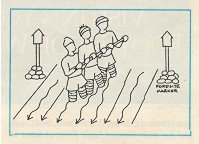
Fine rock flour washes downstream with the glacier's meltwater. In Chugach the dominant rock is graywacke which colors the streams a muddy gray-brown. These opaque waters hide the river bottom, making crossing on foot uncertain and navigating a boat difficult.
High Water Happens When It's Hot
Most rivers drop during long hot summers. Glacial rivers rise! Glaciers melt more on hot, sunny days. Close to a glacier, river levels rise dramatically on sunny afternoons and drop during cool early morning hours. Rainstorms also increase glacial melt, as well as add their own runoff to a river. Occasionally, large rainstorms will swell glacial rivers and fill all channels from shore to shore. Evidence of these floods is seen in the piles of driftwood left high and dry on gravel islands.
Low Water Happens When It's Not
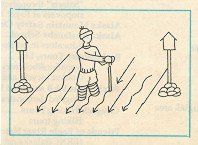
When days shorten and temperatures drop, so do the rivers. Visitors will hardly recognize these rivers in the winter. Raging torrents become small shallow streams of clear sparkling water that is, until they freeze over!
To Cross or Not To Cross
Many trails and routes in Alaska will lead you to streams and rivers without bridges. Because the water can be cold, opaque and subject to quickly changing levels, a few tips can make your stream crossing safer and more comfortable.
Choose your site
At marked ford sites (like those on the Crow Pass Trail), cross directly between the posts on either side. It's the shallowest place. At unmarked sites, cross at the widest and most shallow place. Avoid cutbanks. Test the water depth with a walking stick or by throwing fist-sized stones ahead and listening to the splash.
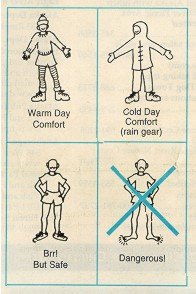 Choose your time
Choose your time
Glacial rivers swell under hot sun or heavy rains, and are usually lowest during early morning hours (6 a.m.). If a river looks or feels too full to cross, wait. It may drop significantly. Remember, you never have to cross. You can go back the way you came, or sit and wait for help.
Fuel your body
Adequate food and water will help your body create the necessary energy to fight hypothermia.
Loosen pack straps
Undo the waistbelt so you can drop it if you fall. Seal important items (sleeping bag, dry clothes) in plastic.
Dress Properly
The right clothing will keep you safe and a lot more comfortable. Always wear shoes or boots. Cold temperatures can cause numbness and missteps that lead to foot injuries, a disaster in the backcountry. Don't cross in bare legs. Wear quick drying wool or synthetics, never cotton. Save something warm and dry for the other side, just in case.
Use a good technique
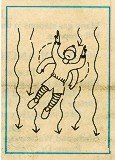
If you are crossing alone, use a stick for extra stability and to explore the bottom. Face the opposite shore or face upstream and cross slowly, letting your feet feel their way. Don't look at the water. Keep your eyes on the far shore to prevent vertigo. Crossing as a group is safer. Stand along the shore in a line, side-by-side, facing the opposite shore. Put the largest and strongest people on the upstream end, and sandwich smaller or weaker people between others. Link arms, or link arms while sharing a stick like a handrail. Enter the water all at the same time, keeping your eyes on the far shore to prevent vertigo.
If you fall
Ditch your gear and swim. Roll over on your back and point your feet downstream so you can fend off boulders. Keep your feet high and don't get them wedged on the bottom. Flipper with your arms toward shore. As soon as you reach shore, get warm and dry. Hypothermia can be a killer.

